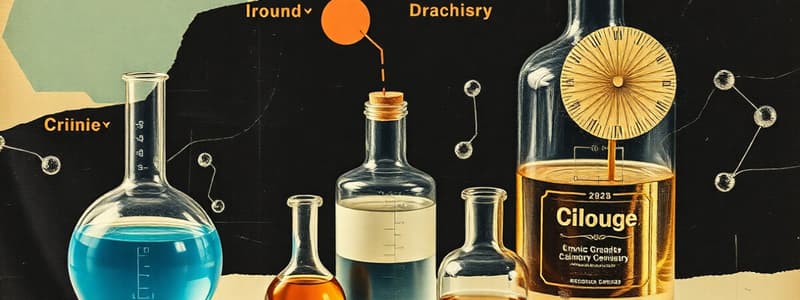Podcast
Questions and Answers
What is the basic structural unit of an element?
What is the basic structural unit of an element?
- Molecule
- Atom (correct)
- Compound
- Ion
Which particles are found in the nucleus of an atom?
Which particles are found in the nucleus of an atom?
- Neutrons and Electrons
- Electrons and Protons
- Protons and Neutrons (correct)
- Protons, Neutrons, and Electrons
What charge do electrons possess?
What charge do electrons possess?
- Negative charge (correct)
- Variable charge
- Positive charge
- No charge
In a neutral atom, what is true about the number of protons and electrons?
In a neutral atom, what is true about the number of protons and electrons?
What characteristic of electrons distinguishes them from protons and neutrons?
What characteristic of electrons distinguishes them from protons and neutrons?
What does the atomic number (Z) represent in an atom?
What does the atomic number (Z) represent in an atom?
Which equation correctly represents the calculation of neutrons in an atom?
Which equation correctly represents the calculation of neutrons in an atom?
What is the primary difference between isotopes of the same element?
What is the primary difference between isotopes of the same element?
If chlorine has an atomic number of 17, how many protons does a chlorine atom contain?
If chlorine has an atomic number of 17, how many protons does a chlorine atom contain?
How is the atomic mass of an element calculated?
How is the atomic mass of an element calculated?
Flashcards are hidden until you start studying
Study Notes
Composition of the Atom
- An atom is the smallest unit of an element that retains its chemical properties.
- Atoms are composed of three fundamental particles: protons, neutrons, and electrons.
Atomic Structure
- The nucleus is the center of the atom, containing protons (positively charged) and neutrons (neutral).
- Electrons, which are negatively charged, orbit the nucleus at high speeds within a large volume of space.
Atomic Particles
- Protons and electrons have equal but opposite charges; in a neutral atom, their numbers are equal.
- Mass number (A) is the sum of protons and neutrons, whereas the atomic number (Z) represents the number of protons.
Isotopes
- Isotopes are variations of the same element with the same number of protons but different numbers of neutrons.
- Isotopes share the same chemical properties but may have different physical properties, some of which may be radioactive.
Atomic Mass
- Atomic mass is a weighted average of the masses of an element's isotopes, often represented as a decimal.
- Elements can consist of multiple isotopes in various natural abundances, influencing the atomic mass calculation.
Periodic Table and Periodic Law
- The periodic table was developed independently by Dmitri Mendeleev and Lothar Meyer, showing a regular variation in element properties based on atomic mass.
- The periodic law states that properties of elements are periodic functions of their atomic numbers.
Classification of Elements
- Elements are categorized as metals, nonmetals, and metalloids based on their properties:
- Metals: Typically lose electrons during chemical reactions; conduct electricity and heat well, possess malleability and ductility, and are solid at room temperature.
- Nonmetals: Often gain electrons, form negative ions, and are generally brittle solids or gases with properties opposite to metals.
- Metalloids: Exhibit intermediate properties between metals and nonmetals.
Electron Arrangement
- Electron configuration, which describes how electrons are arranged in an atom, is critical for understanding compound formation.
- The Schrödinger equation provides a probabilistic model for electron locations, recognizing both particle and wave properties.
Principal Energy Levels
- Electrons are found in regions called principal energy levels labeled by quantum number n (n=1, 2, 3, etc.).
- Higher n values indicate higher energy and farther distance from the nucleus, with each level having a corresponding number of sublevels.
Sublevels and Electron Capacity
- Each principal energy level n has n sublevels (e.g., n=1 has one sublevel, n=2 has two).
- The total electron capacity of a principal energy level is given by the formula 2n²; for instance, n=1 can hold 2 electrons, and n=2 can hold 8 electrons.
Studying That Suits You
Use AI to generate personalized quizzes and flashcards to suit your learning preferences.




